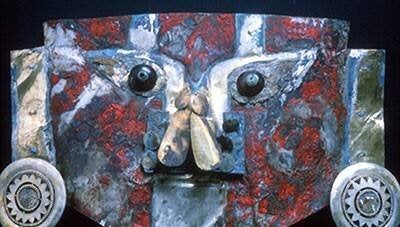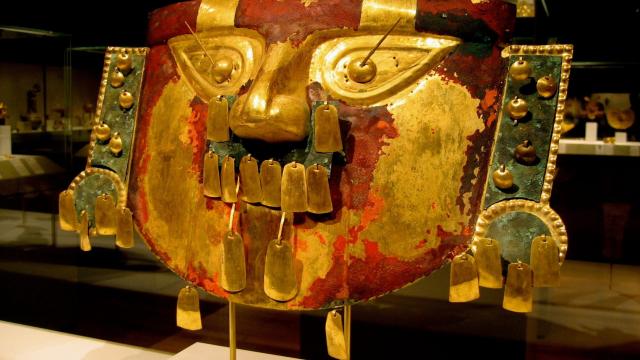A team of researchers recently investigated the paint coating a 1,000-year-old gold mask taken from an elite tomb of a community in western Peru that is today known as the Sicán. They were intrigued to find that the bright red paint contained human blood.
The pigment that gave the paint its colour was identified as cinnabar more than 30 years ago, but the binder — the stuff that makes pigment spread and stick to a surface — remained a mystery. The interdisciplinary team took a sample of the paint and analysed its proteomics, or its constituent proteins, by mapping the sample’s elements to a protein database. They turned up proteins from bird egg and human blood, as well as human saliva, keratin, and skin; their research was published last month in the Journal of Proteome Research.
“Blood proteins appeared in the first search against all natural proteins, which led to a search against the blood database, which yielded a match against chimpanzee (Pan troglodytes),” said Luciana Carvalho, an archaeologist at the University of Oxford specializing in organic residues on metal objects, in an email to Gizmodo. “As chimps are not found in Peru, we conducted a search against human blood protein database, which provided perfect matches.”
The saliva, skin, and keratin (which turns up in many parts of our bodies, but most notably in our hair and nails) proteins were eliminated from the team’s analysis, as they may have been later contamination of the mask that occurred in its handling rather than any original burial treatments.
The type of bird the egg protein belonged to is uncertain; though some chicken bones in South America date to before the arrival of Europeans, general consensus is that the Columbian exchange brought the chicken to the Americas. Muscovy duck is an option, but the proteins are too degraded to know for sure, according to the researchers.

Gold funerary masks pop up throughout elite burials of Sicán individuals, though, as the researchers write, older (often looted) finds were cleaned carelessly, smoothed out, or even had their paint and adornments stripped for their presentation in museums. As a result, the Sicán mask in the study is a rare occasion to study how these masks would have actually been treated for burial.
Cinnabar-based paints would have been reserved for elites in the Sicán community, while regular folk were probably stuck using ochres, the researchers wrote. Study author Izumi Shimada, an archaeologist at Southern Illinois University who specialises in the Sicán culture, proposes the blood on the mask indicates the paint was supposed to represent “life force,” an idea supported by symbolic importance of blood among the Sicán; analysis of human sacrifice victims from the region has suggested that the individuals were cut to maximise bleed-out, rather than just killed, according to Carvalho.

“There are a few Spanish Colonial written documents (dating to the 16th century. Note that there was no writing as we know it in the pre-Hispanic Andes) that recorded pre-Hispanic myths that tell that elites originated from stars or eggs that were different from those of commoners — that they had a totally distinct ancestry from that of the commoner,” Carvalho said.
“It is quite likely that Sicán elites (as with elites in many other ancient cultures) promulgated a vision/myth that distinguished them from the rest of the society and thus legitimized their power, wealth, etc,” Carvalho added. “Thus, we may think of the use of human blood as a binder as an extension of the religious dogma that the Sicán elite promulgated so that they could attain the transformation to become deified ancestors.”
Adding credence to the “life” part of “life force,” the mask-wearing Sicán was found inverted beside the remains of two adult women in birthing and midwifing positions, which “suggests that the desired effect was the rebirth of the deceased leader,” the researchers wrote. Also in the tomb were the remains of two children in crouched positions.
